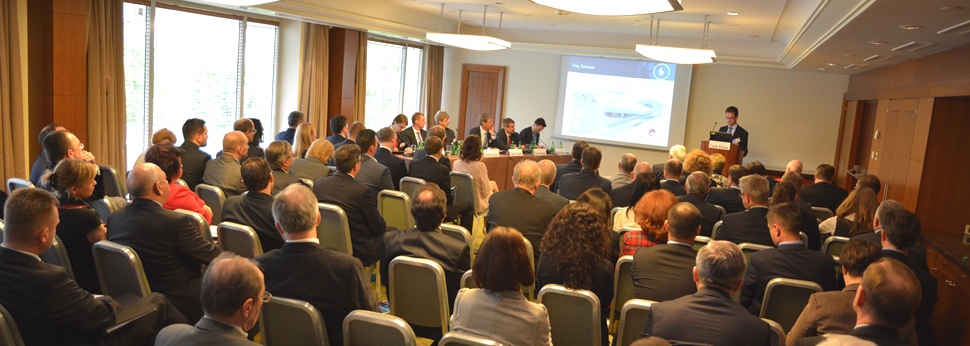Two Platforms for Europe
The State Visit taking place from May 6 to May 9 2014 in Poland and led by Grand Duke Henri served to identify new business opportunities, particularly in the field of logistics. The strategies of the two hubs are similar: Luxembourg wants to become a gateway to Western Europe while Poland sees itself as a distribution centre for Eastern Europe. Linking Bettembourg , Poznan and Warsaw would allow both countries to multiply their reach and potential. Multimodal transport in particular seduced several Polish transport associations. The Cluster for Logistics participated in the visit and made promising contacts.
The state visit helped to strengthen bilateral and trade ties. Polish Businessmen and media also consider the connection between the Luxembourg and Poland to be strategically important. And both countries will benefit from further collaboration. The Polish president, Bronislaw Komorowski , stressed that a "good deal" is a collaboration where both partners are satisfied .
Luxembourg is certainly not unknown to the Polish business world because our country is one of the largest direct investors, mainly through investment funds. In addition to financial interests, Luxembourg can become a platform of choice for Polish companies, especially in the multimodal transport. And there is huge potential. Such as Luxembourg, Poland continues to grow in 2014 and 2015 as Polish GDP is expected to increase by more than 3.0 % per annum.
At the "Business and Financial Forum" in Warsaw, which hosted hundreds of visitors, Grand Duke Henri stressed the importance of diversification Luxembourg . He acknowledged that in the logistics business, Poland and Luxembourg were ideal partners for connecting the East with the West. Activities between the two countries can be further improved, said the Minister of Economy, Etienne Schneider. He recalled that the logistics sector is not only a great provider of revenues but can also generate jobs for less skilled workers.
A workshop dedicated to logistics
A purely logistical delegation accompanied the economic mission organized by the Chamber of Commerce. The Cluster for Logistics moderated a dedicated logistics workshop involving Luxembourg and Polish entrepreneurs. Carlo Thelen, director of the Chamber of Commerce and Chairman of the Cluster for Logistics, presented the Luxembourg market. Luxembourg and Polish specialists discussed the interest a topic that has attracted more than 100 visitors. The event also favoured networking between Luxembourg and Polish entrepreneurs.
While many European logistics operators favour the truck for reasons of cost and flexibility, this observation is even more remarkable in Poland. The country is the largest provider of services cross-border road transport, both for third countries and for cabotage. The accession to the European Union in 2004 has greatly boosted the activities in this area.
The number of transportation companies has increased dramatically in a decade, passing from 8,700 companies in 2002 to 26,600 in 2012. In the past ten years, the number of vehicles used by these companies increased from 32,000 to 144,000 units. At the same time the government is modernizing the road infrastructure. The motorway network currently stretches over 1,500 km and should be more than doubled in the years to come. But the railroad sector is being improved as well.
New multimodal strategy
Facing competition and increased costs, many companies are clearly reviewing their business model, transforming from simple carrier to a logistics provider. This approach favours the development of services that aim beyond the mere transport of goods. This is the right answer to an increasingly competitive European market. It also involves the implementation of multimodal solutions which are more efficient than the single truck transport.
Some carriers consider that the two means of transport, rail and road, are competitors. This is understandable if we take into account the political discourse which favoured rail transport and fought road-only carriers. But the idea is clearly changing. Many transport companies and politicians understood that both means of transport are complementary when used correctly. Companies can significantly reduce their CO2 emissions while facing the rising labour costs of drivers, higher fuel prices and tolls or the driving prohibition during holidays.
But it is imperative to clearly lay out the characteristics of multimodal transport, which allows for cost and time savings on long trips. Polish witnesses pointed out that a first attempt to multimodal transport, where the entire truck plus the driver were on a train, had failed a few years ago, further strengthening resentments. Piggyback trailers alone have meanwhile won the favour of several Polish transport associations. According to them, the multimodal transport is the future and multimodal transport should be the means of choice for long-distance transport. Even if there are still challenges to implement the connection, the willingness to change is there, assured representatives of three Polish transport associations in Warsaw.








































































































































